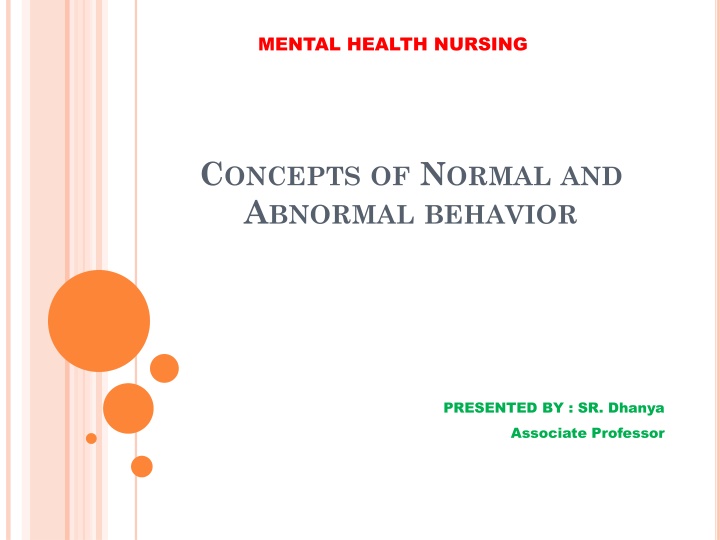
Mental Health Nursing Concepts of Normal and Abnormal Behavior
Explore the fundamentals of mental health nursing as presented by Sr. Dhanya, an Associate Professor. Delve into defining normal and abnormal behavior, factors influencing behavior, traits of individuals with normal and abnormal behavior, and psychoanalytic models. Gain insights into the continuum of behavioral responses and traits associated with both normal and abnormal behavior.
Download Presentation

Please find below an Image/Link to download the presentation.
The content on the website is provided AS IS for your information and personal use only. It may not be sold, licensed, or shared on other websites without obtaining consent from the author. If you encounter any issues during the download, it is possible that the publisher has removed the file from their server.
You are allowed to download the files provided on this website for personal or commercial use, subject to the condition that they are used lawfully. All files are the property of their respective owners.
The content on the website is provided AS IS for your information and personal use only. It may not be sold, licensed, or shared on other websites without obtaining consent from the author.
E N D
Presentation Transcript
MENTAL HEALTH NURSING CONCEPTSOF NORMALAND ABNORMALBEHAVIOR PRESENTED BY : SR. Dhanya Associate Professor
SPECIFIC OBJECTIVES Define Normal and abnormal Behavior Behavioral Behavioral Responses Responses Traits of persons with Normal behavior Models Models of of Normal Normal and and Abnormal Abnormal Behavior Behavior Factors Factors influencing influencing Normal Normal and and Abnormal Abnormal behavior behavior
I INTRODUCTION NTRODUCTION Psychiatric nursing is a branch of nursing that deals with care of psychiatric pt s who are considered abnormal in their behavior Abnormal means deviation or different from the norm or standard Influenced by socio-cultural factors
N NORMAL ORMALBEHAVIOR BEHAVIOR Emotionally upset at various times Temporary change in feelings, thinking & behavior Examples: Examples: Fear of impending exams (anxious and worry) Loss/excess of appetite, sleep, If unable to write exam or loss of memory (Emotional illness) Similarly, death of husband/child can affect mother She may cry frequently, unable to sleep/eat, neglect other family members & household work
C CONTINUUM ONTINUUMOF OF B BEHAVIORAL EHAVIORAL R RESPONSES ESPONSES Normal(Adaptive responses) Abnormal (Maladaptive responses) Anticipatio n Mild Extreme Severe Moderate
TRAITSOFPERSONSWITH NORMALBEHAVIOR Attitudes towards self 1. Perception of reality 2. Resistance to stress 3. Environmental mastery 4. Autonomy 5. Growth, self actualization 6.
TRAITSOFPERSONSWITHABNORMALBEHAVIOR Deviation from statistical norms 1. Deviation from social norms 2. Maladjustment 3. Personal distress 4. Personal immaturity 5.
MODELS P PSYCHOANALYTIC SYCHOANALYTIC M MODEL ODEL Emphasizes man s basic instinctual drive Normalcy is ability to gratify these drives within limits imposed by society Abnormalcy is faulty or exaggerated impulses
B BEHAVIORISTIC EHAVIORISTICMODEL MODEL Emphasizes attempt to adapt to environmental stimuli overt behaviour as person s Abnormally is ineffective adaptation due to learning of maladaptive responses or failure to learn adaptive ones
M MEDICAL EDICALMODEL MODEL Medical model considers organic pathology as the definite cause for mental disorder. According to this model abnormal people are the ones who have disturbances in thought, perception and psychomotor activities. The normal are the ones who are free from these disturbances.
H HUMANISTIC UMANISTICMODEL MODEL Emphasizes responsible self direction & self fulfillment man s natural tendencies towards Abnormality is failure to develop one s full humanity due to either blocking or distorting these tendencies
S SOCIO OCIO- -CULTURAL CULTURALMODEL MODEL The beliefs, norms, taboos and values of a society have to be accepted and adopted by individuals. Breaking any of these would be considered as abnormal. Normalcy is defined in context with social norms prescribed by the culture. Thus cultural background has to be taken into account when distinguishing between normal and abnormal behaviour.
S STATISTICAL TATISTICALMODEL MODEL It involves the analysis of responses on a test or a questionnaire or observations of some particular behavioral variables. The degree of deviation from the standard norms arrived at statistically, characterizes the degree of abnormality. Statistically normal mental health falls within two standard deviations (SDs) of the normal distribution curve.
E EXISTENTIAL XISTENTIALMODEL MODEL Emphasizes primary reality of the person s conscious experience & decisions Abnormality is failure to achieve an adequate self identity & a meaningful way of life
I INTERPERSONAL NTERPERSONALMODEL MODEL Emphasizes role of interpersonal relationship in shaping development & behavior Abnormality is faulty interpersonal relations & accommodations of a pathological type
F FACTORS ACTORSINFLUENCING INFLUENCING A ABNORMAL BNORMALBEHAVIOR BEHAVIOR Organic factors Psychological factors Sociological factors
SOCIO-CULTURAL FACTORS War & violence Group prejudice Economic & employment problems Technological & social changes Mass media Impact of western culture Stigma Joint family system
